Autopsy Meizu MX3
Welcome, Habraludi! We are finally ready to present you another material of the Autopsy format, this time we will understand the "insides" of the top-end Meizu MX3 music smartphone - let's take a look at the components of the device, take a look at how they are assembled inside the case and note some features of the assembly.
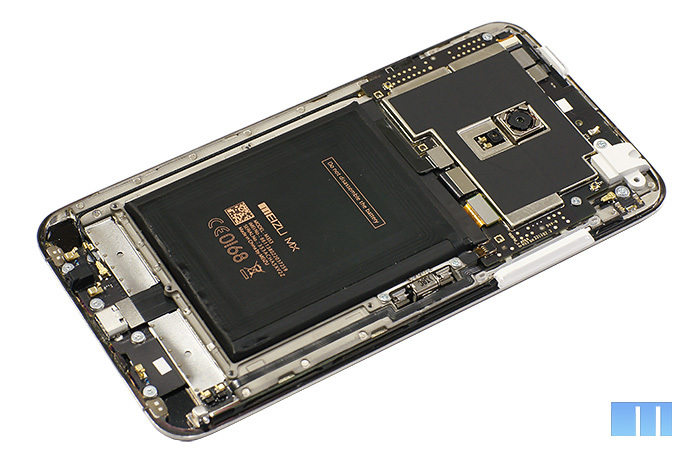
')
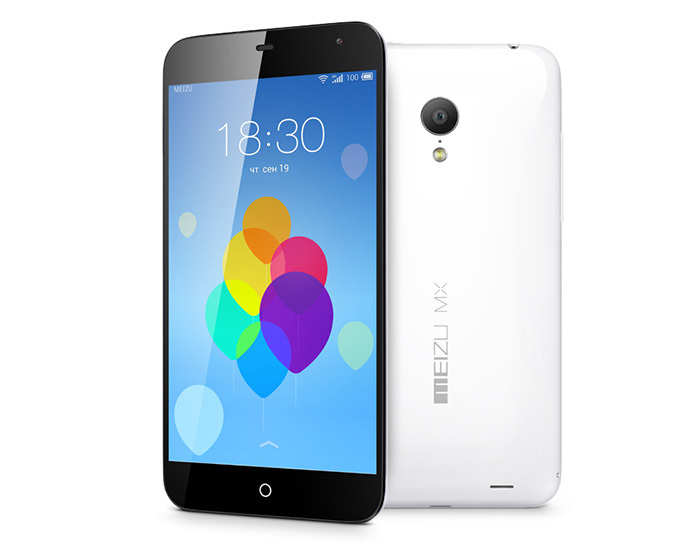
As you probably know, despite the slightly changed design, the layout of the main elements in the Meizu MX3 remains the same as in the Meizu MX2. On the top of the smartphone there is a power button and a 3.5 mm audio jack, a microUSB port is located on the bottom, and a volume rocker is placed on the left edge.
Has not undergone special changes and the body itself. As before, it is based on a metal frame cut from a single piece of stainless steel. The back cover is made of two-layer plastic, which is also familiar to us from the company's previous device. The method of fastening the lid remained the same - to fix it, a special bracket is used, which is located on the left edge of the device. But the plastic retainers have changed a bit. If earlier they were located only along the edge of the lid, then now several more clamps, located closer to the center, were extracted to them.

As in the Meizu MX2, in the new MX3 all the "stuffing" is hidden under a special protective casing. The casing itself now consists of a single part and is entirely made of plastic. Due to this, even despite the increased dimensions of the device, the weight of the smartphone has remained almost the same - the difference with the Meizu MX2 is only one gram. In addition, it became much easier to remove the casing - now it is enough to unscrew 11 screws.
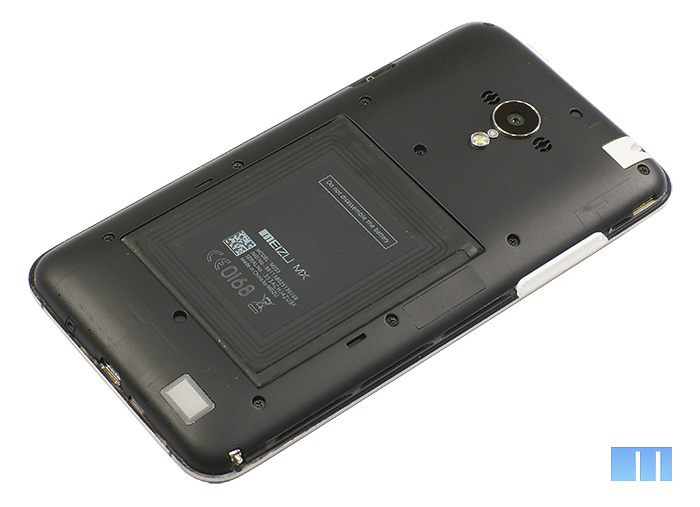
The second noticeable difference in comparison with the MX2 was a different arrangement of the protective glass of the camera and the flash LED. If earlier they were located on the back cover of the smartphone, now they have been transferred to the protective casing. That is why inexpensive replaceable covers of different colors are already available for the MX3, whereas for the MX2 this part of the case was more expensive.
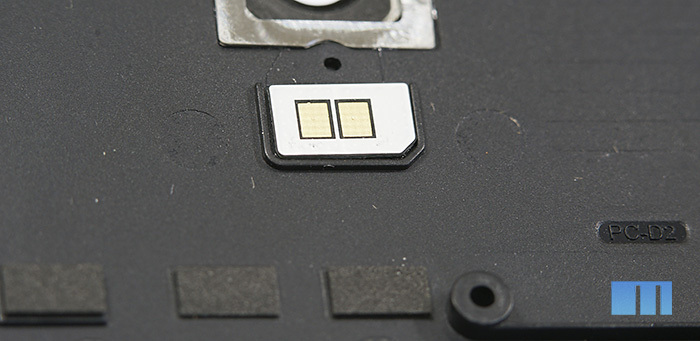
After the cover is removed, you can remove the battery. The main thing is not to forget to disconnect from the main board a flat cable that goes along its top. A similar cable is located in the upper right corner of the battery and is used to connect an NFC antenna.
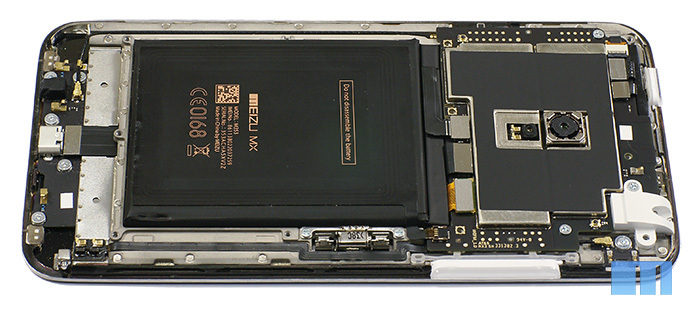
A special mount for the battery is not provided, it is simply glued to the body with double-sided adhesive tape. And, although it is peeled off without much effort, in the process it can be accidentally damaged, you need to be careful.
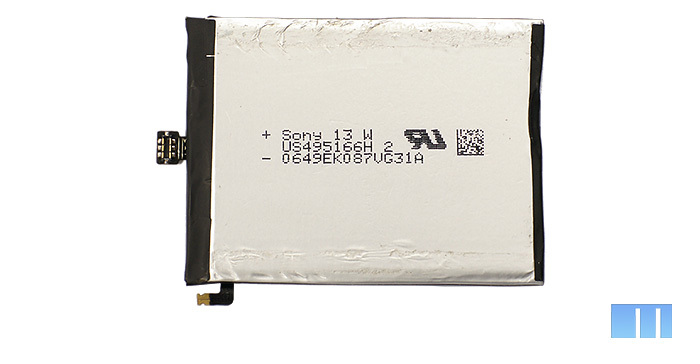
At the bottom of the smartphone is a small board with the Home key sensor and a micro USB port. As in the past, the company's smartphone, the sensor surface of the central button is covered with a layer of fluorescent paint. Thanks to this solution, the button glows even when the smartphone is completely off.

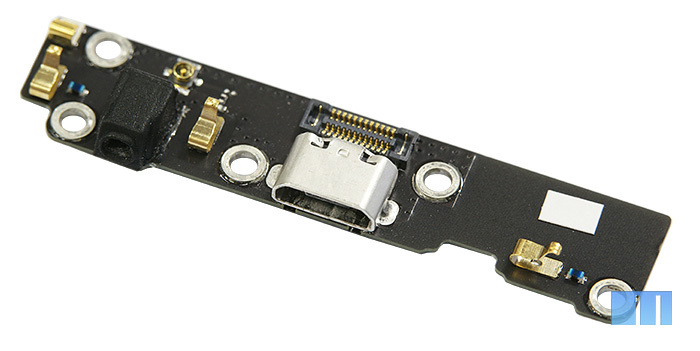
It connects to the main board with a long loop that runs under the battery.

Next to the volume rocker is a vibration motor module, it is mounted on two screws.
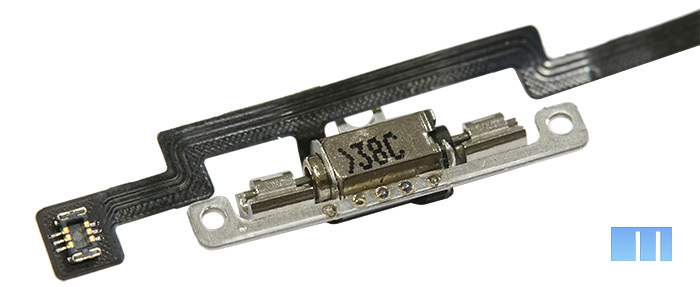
In the upper right corner of the smartphone is a white audio module with a 3.5 mm jack. It is also attached with just two screws and removed in a couple of seconds.
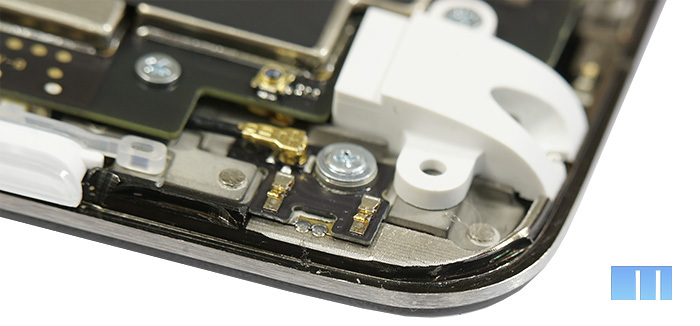
On the left side of the module there is a row of five contacts through which the signal is transmitted to the main board.
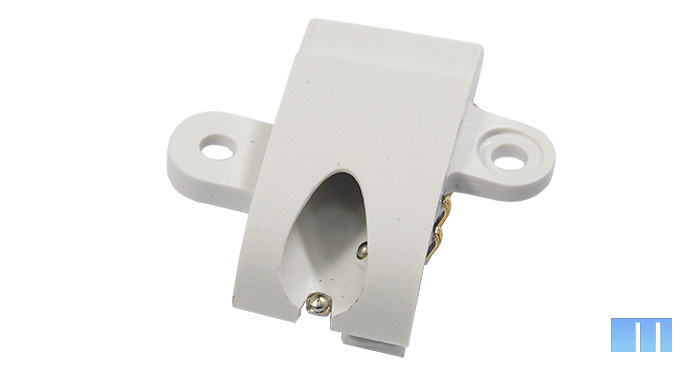
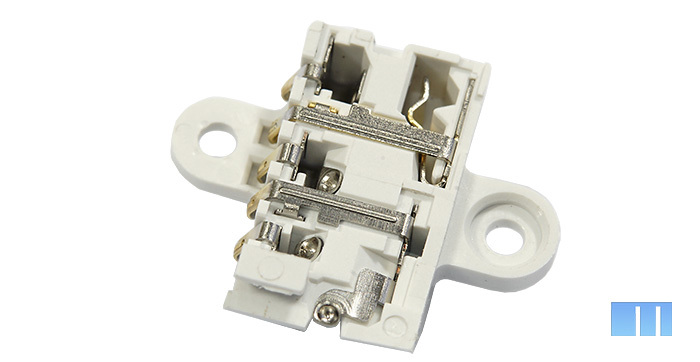
Let us turn to the most interesting part - the main board. As a base, the black PCB, which is usual for Meizu, is used, but its shape has changed a lot. The photo below shows the rectangular Meizu MX3 board and the L-shaped Meizu MX2 board.
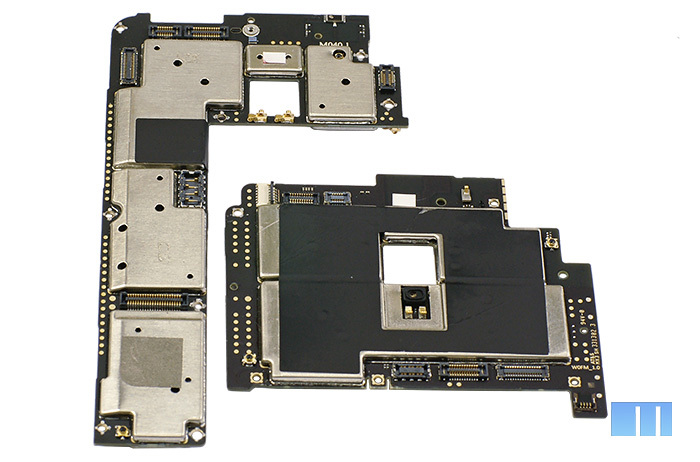
As you can see, the outer side of the board is almost completely covered with aluminum protective screens, which were not too easy to remove without special equipment. But its front side is almost completely open, the protective screen covers only a group of chips in the upper right corner. Over it passes a cable from the camera module to the board itself.

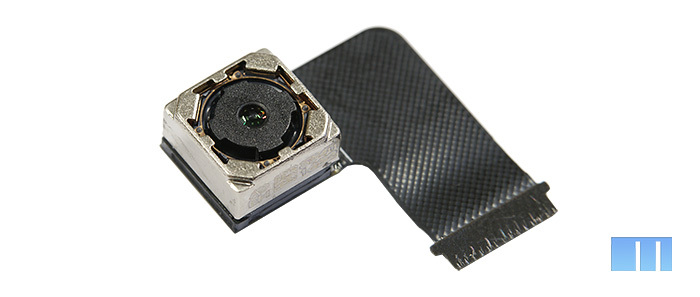
By the way, about the camera. The Meizu MX3 uses an 8 MP module (a Sony Exmor BSI sensor, an IMX179 CMOS chip, a 1.4 μm photosensitive element), and five lenses. F / 2.0 aperture, 74 ° angle.
After all the protective screens have been removed, you can proceed to the analysis of the main modules and chips located on the board. Let's start with its front side, which is facing the screen of the smartphone.

First of all, pay attention to the bottom of the board. This is where the “heart” of the smartphone is - SoC Samsung Exynos 5410, also known as Exynos 5 Octa. It is worth noting that a similar solution was chosen by Samsung and for its flagship Samsung Galaxy S4 GT-I9500.
This is one of the world's first eight-core CPUs. It is based on eight cores: four low-cost ARM Cortex-A7 and four powerful ARM Cortex-A15, no more than four can work at the same time. This is precisely the feature of the big.LITTLE architecture, which allows to reduce energy consumption by switching between the productive and economical four cores in time. More information about it can be obtained on the official website of Samsung.
 Summary of SoC
Summary of SoC
To work with graphics using a three-core graphics processor SGX544MP3 with a clock frequency of 533 MHz. Of its features worth noting hardware support for DirectX 9, OpenGL ES 1.1 and OpenCL 1.1.
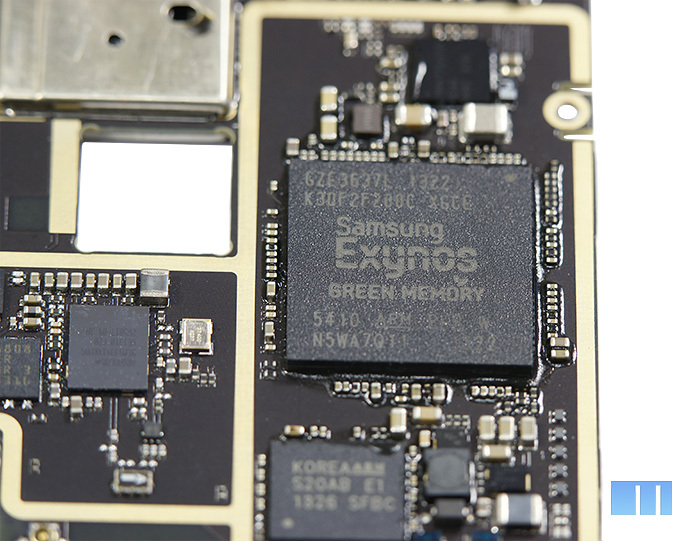
The right corner of the board is almost completely occupied by the microSIM card tray. Between it and the processor is a small bright black chip - “DC-to-DC Controller” Maxim MAX776, which is responsible for power management.
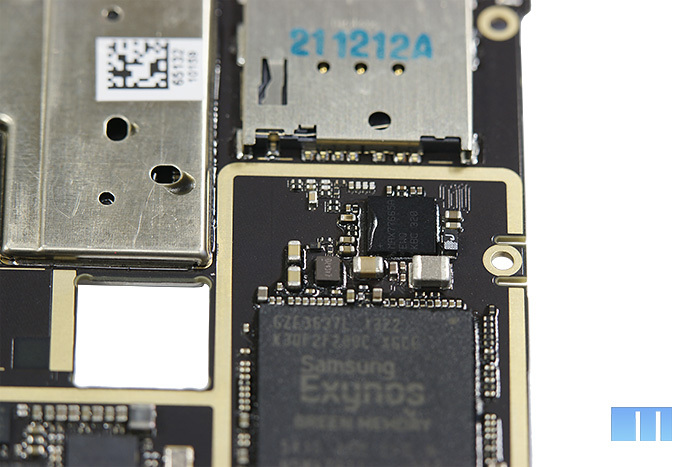
Closer to the left side of the board, you can see quite a tiny chip "bipolar power supply for display" - TPS65132 from Texas Instruments, capable of working with TFT-LCD panels up to 10 inches.
 Chip description
Chip description
But the chip to its left has a much larger size. This ISP or Image Signal Processor, responsible for the camera. As in its previous devices, Meizu decided to use the Fujitsu ISP chip. However, the chip itself is slightly different - not the MBG048, as in the two previous smartphones, but the S20AB.
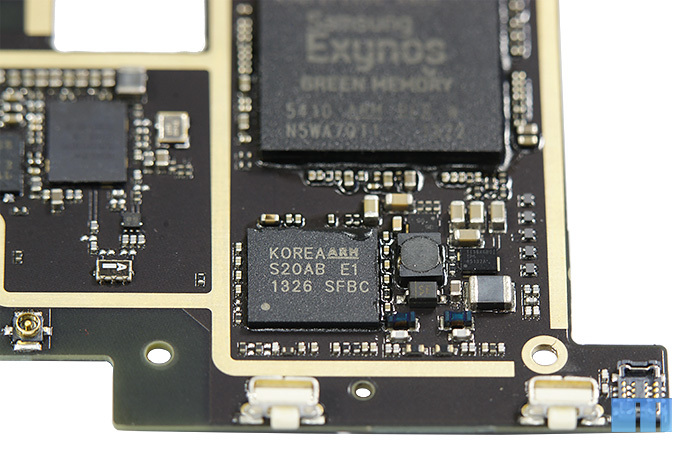
Let's go to the top side of the board. On the left side of the cut-out for the camera module is another chip, which has also been upgraded. We are talking about the Broadcom chip, which is responsible for the operation of wireless interfaces. If the Meizu MX2 was used for this purpose by the Broadcom BCM4430, then in the MX3 it was decided to install Broadcom BCM4334. Unfortunately, there is very little information about the BCM4430, therefore it is difficult to say exactly what the difference is between them. It remains only to be content with the description of the BCM4334. According to him, the new version of the chip has less power consumption than the past, supports the standards of Wi-Fi 802.11a / b / g / n, Bluetooth 4.0 + HS and technologies such as Wi-Fi Display and Wi-Fi Direct. Another feature of Broadcom BCM4334 is support for FM radio (which, however, is absent in the smartphone itself).
 Chip Summary
Chip Summary
Let's now consider a group of chips placed to the right of the cutout for a camera module. It is this part of the board that was covered with an aluminum shield.
RF6260 is used as a “power amplifier module”, a chip responsible for the operation of a smartphone on 2G / 3G networks. Curiously, the RF6260 also supports 4G, which is not available in the smartphone itself. A similar chip was used in the past of the company's flagship, the Meizu MX2.
 Chip description
Chip description
Next to it is the blue module - Epcos D602 RF filter.
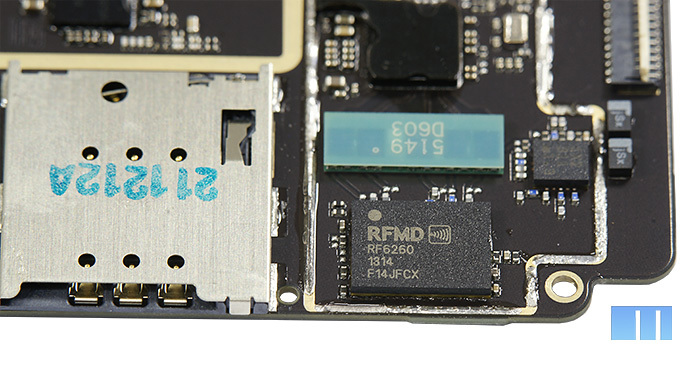
Slightly closer to the center is the RF PMB5712 radio transceiver. Together with the PMB9811 modem, which is located on the opposite side of the board, it is part of the Intel XMM 6260 platform.
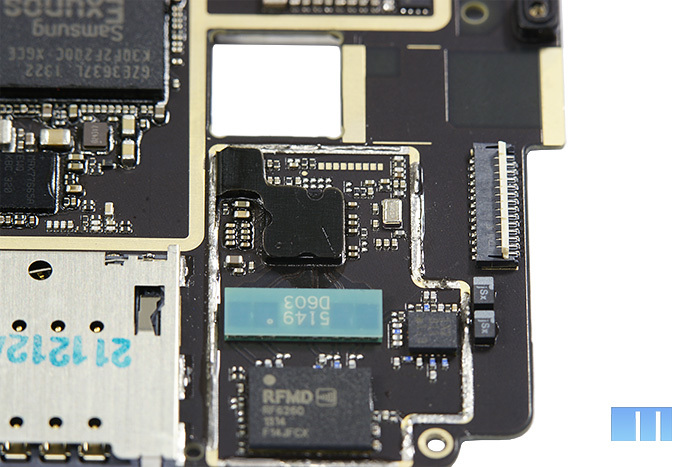
Now it's time to turn over the board and see what's interesting is on its reverse side. Like last time, let's start from the bottom.
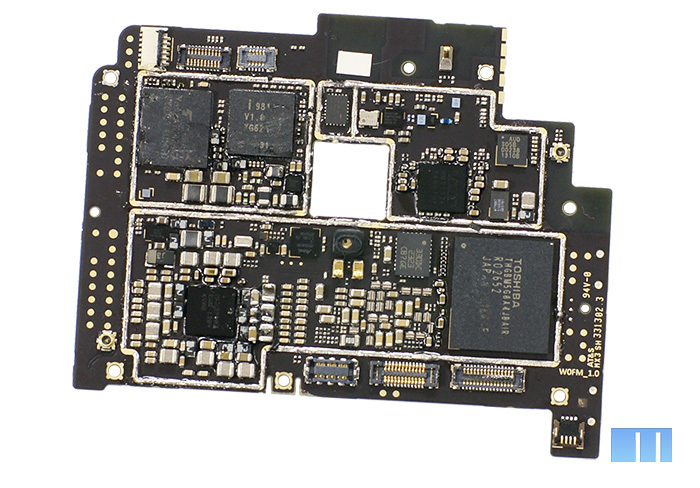
In the left corner is a group of power-related chips — the barely noticeable DC-DC Converter RF Micro Devices 6560 and the slightly larger Integrated Controller Maxim MAX778.

The next module, Atmel 32UC3, is located almost in the center of the board. This is a 32-bit microcontroller of the “system-on-chip” type, created on the basis of the AVR32 UC RISC-processor with an operating frequency of up to 50 MHz. According to the manufacturer, the main focus of this microcontroller was placed on high performance with low power consumption. More information can be found in the PDF file.
 Chip description
Chip description
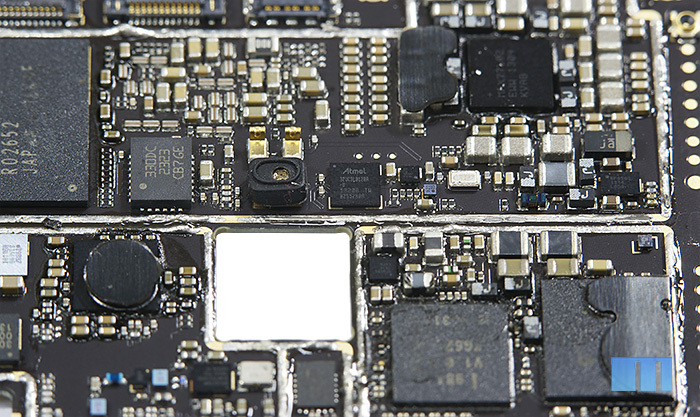
The entire right corner is occupied by a large memory module with a well-distinguished Toshiba brand. Interestingly, in the photographs of the board that had previously appeared on the network, the memory module was from SanDisk. The same module was used in the past, the company's smartphone.
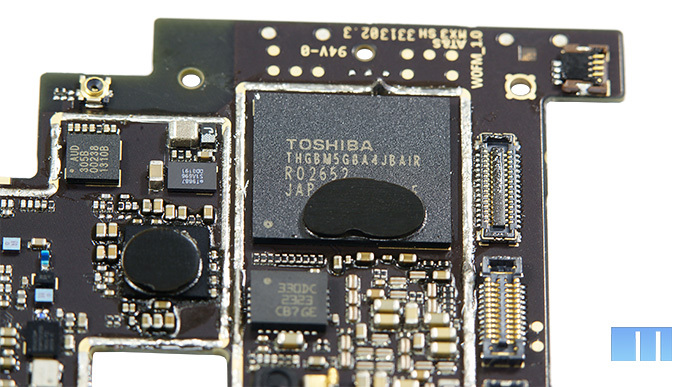
Another Toshiba memory module, this time already operational, is located in the left corner of the upper part of the board. In our case, we couldn’t see its labeling, but, according to the Chinese resource bbs.meizu.cn, this is the Toshiba D8 + Toshiba Y8A0A111434KA module. Unfortunately, it was not possible to find its detailed specifications.
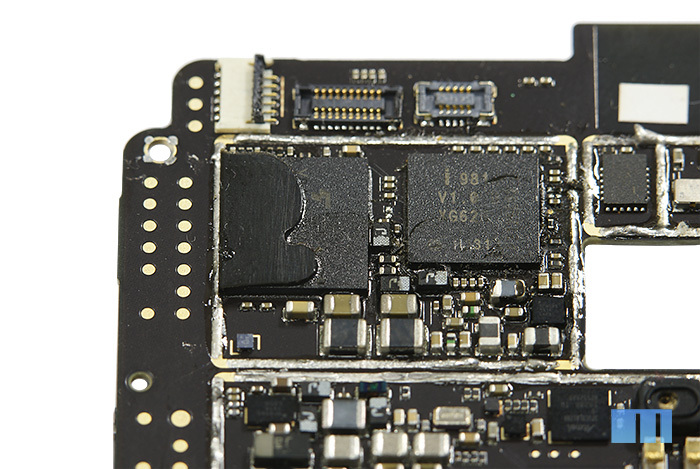
A little to the right is the modem Intel PMB9811. Let me remind you that it is part of the Intel XMM6260 platform, already mentioned above. It should be noted that this platform is not a new, but proven and reliable solution. It was originally developed by Infineon and was called X-GOLD626. And even then it was used in a number of well-known smartphones, for example, Samsung Galaxy S2. Later, after Intel acquired the Infineon Technologies wireless division, this solution was given the name Intel XMM6260.
 Chip description
Chip description
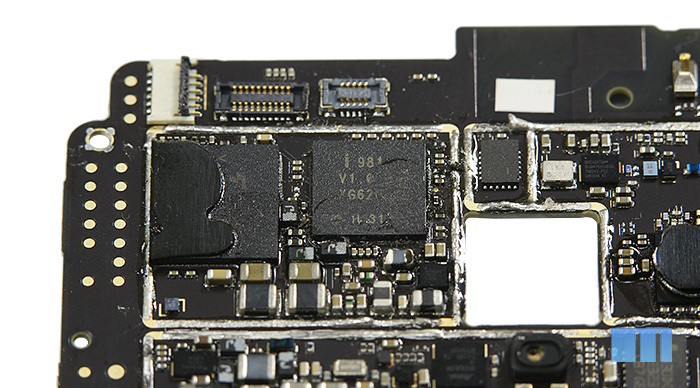
Just above the camera cut-out is another Broadcom chip. This chip belongs to the third generation of GNSS solutions (Global Navigation Satellite System or Global Navigation Satellite System) and can provide simultaneous use of four navigation systems at once - GPS, GLONASS, QZSS and SBAS. For fast positioning, Broadcom BCM4752 supports work with a number of additional sensors: an accelerometer, a gyroscope, an atmospheric pressure sensor, and others.
 Chip Summary
Chip Summary
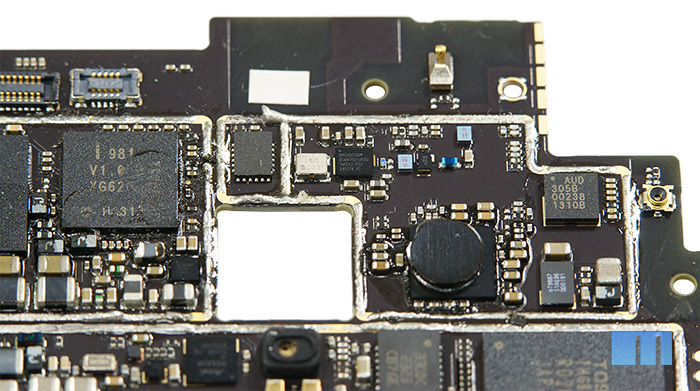
Virtually the rest of the board’s corner is reserved for working with sound. Given that the Meizu MX3 is a music smartphone, this part of the board is of particular interest to us.
First of all, attention is drawn to the large square of the audio chip. As you can see, Meizu almost always prefers Wolfson audio chips. For example, in Meizu MX and in Meizu MX2, Wolfson WM8958E was installed. The latest flagship of the company, the Meizu MX3, which also features the Wolfson chip, but already a new model, the Wolfson WM5102, was no exception. According to the company, it is thanks to this chip, compared to last year’s flagship, the sound quality in the MX3 has been greatly improved. The power of the head amplifier has increased by 3 times, the level of harmonic distortion has been reduced to 0.002%, and the signal-to-noise ratio has been increased to 113 dB. Another distinctive feature of the chip is support for Dirac HD technology.
Wolfson has long been known on the market for audio chips for portable devices and audio chips from this company can be found in mobile devices from a variety of manufacturers. In particular, the Wolfson WM5102 is used in the Samsung Galaxy S4 16Gb GT-I9500. Read more about this chip on Wolfson Microelectronics official website.
 Chip Summary
Chip Summary
 Chip description
Chip description
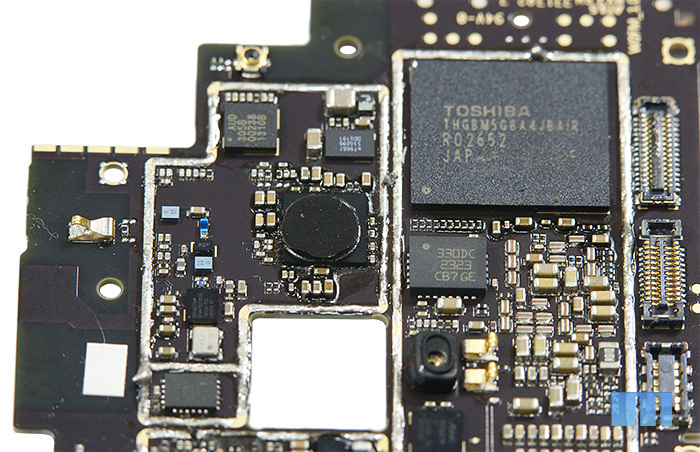
But an additional voice processor, directly responsible for voice processing, remained the same - Audience 305B.
 Chip description
Chip description
The NXP TFA9887 was chosen as the audio amplifier module, which once again underlines the “musical” orientation of the smartphone. This module can provide 2.6 watts RMS power, while most analogs provide only 0.5 watts.
 Chip description
Chip description

In the end I would like to say a few words about the cooling of the board. As the company representatives have already mentioned, the heat sink is carried out on both sides of the printed circuit board, since the heat transfer goes in both directions. The use of thermal paste, graphite and nickel-copper alloy coatings can effectively dissipate heat.
Under the main board there is a module with a light sensor and a proximity sensor, a speaker, and a front camera module (2MP, Exmor R).

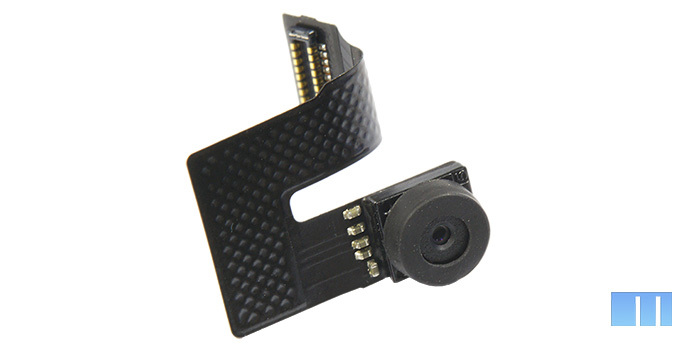

This is how the fully disassembled Meizu MX3 looks like (the lid was left overs).
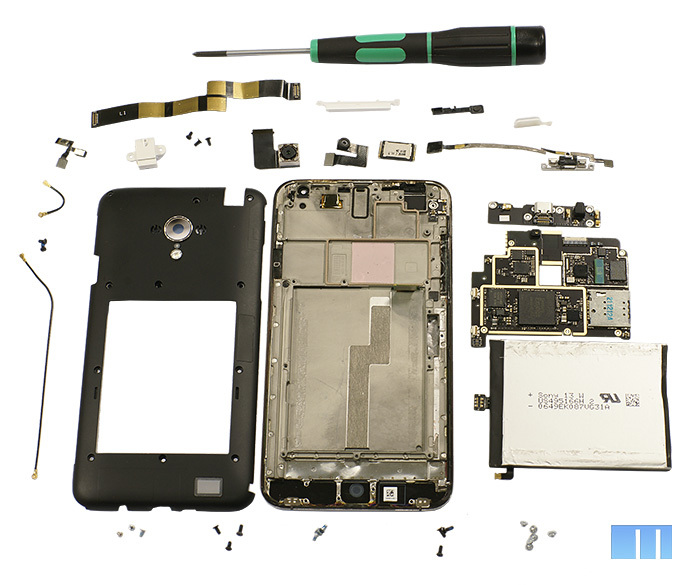
Smartphone Meixu MX3 can not be called a revolution, rather, it is a quality update of the previous model. On the one hand, the smartphone continues the traditions of the Meizu MX family, on the other - it has a number of improvements. We see that when selecting components, the company remained true to old partners, while many of the components of the device were substantially updated. Moreover, this year, special emphasis was placed on the audio part. The internal design of the smartphone is also improved. This is a more practical and convenient protective casing, and another layout of modules. Particularly pleased that the LEDs of the flash and the protective glass of the camera are transferred from the back cover to the inside of the smartphone. Due to this, it will be much easier to change the cover.
Articles about the opening of Meizu MX3 on other resources:
 Meizu smartphone online store in Russia http://mymeizu.ru/
Meizu smartphone online store in Russia http://mymeizu.ru/

Meizu MX3 Specifications
- Operating system : Android 4.2 with Flyme 3 shell
- Communication : GSM / GPRS / EDGE / 3G (WCDMA) / HSPA + 850/900/1800 MHz (2G), 850/2100 MHz (3G)
- Screen : Sharp New Mode 2, 5.1 ”diagonal, 1800x1080 pixels resolution, PPI 415, 1000: 1 contrast ratio, maximum brightness 450 cd / m, 2048 brightness gradations, TOL technology (single module - glass plus sensor), energy-saving PSR technology, protective glass Gorilla Glass 2
- Platform : Samsung Exynos 5410, 8-core processor (4 cores 1.6 GHz Cortex-A15 and 4 cores 1.2 GHz Cortex-A7), 28 nm process technology LP HKMG
- Graphic processor : PowerVR SGX 544MP3 (533 MHz, 3 cores).
- RAM : 2 GB, DDR3
- Memory for data storage : 16/32/64 GB
- Camera : 8 MP (Sony Exmor BSI-sensor, IMX179 CMOS chip, 1.4μm photosensitive element), shooting speed: 20 frames / sec; 5 lenses, F / 2.0 aperture, 74 ° angle, “instant filter” function, video recording 30 fps 1080p, panorama shooting, gyro focus, HDR function, face detection, gesture shot
- Front camera : 2Mp (Sony sensor), video recording 30 fps 1080p.
- Multimedia : Wolfson WM5102 sound chip, Dirac HD technology, Smart PA noise reduction acoustic system with three microphones, Fujitsu four-channel image processing chip
- Supported formats : FLAC, APE, AAC, MKA, OGG, MP3, MIDI, M4A, AMR, WAV, MP4, 3GP, MOV, MKV, AVI, FLV, MPEG, M2TS, TS, JPEG, PNG, GIF, BMP and many other
- Interfaces : Wi-Fi 802.11 b / g / n, 2.4GHz / 5GHz (max. Speed 150 Mbit / s), Bluetooth 4.0, microUSB (support USB-OTG), NFC (except MEIZU MX3 16GB), 3.5 mm for headphones and headsets
- Navigation : GPS / A-GPS / GLONASS, electronic compass
- Optional : touch sensor, light sensor, gravity sensor, electronic compass, gyroscope
- Battery : 2400 mAh, Sony, dual chip for power management
- Dimensions : 139.0 x 71.9 x 9.1 mm
')

As you probably know, despite the slightly changed design, the layout of the main elements in the Meizu MX3 remains the same as in the Meizu MX2. On the top of the smartphone there is a power button and a 3.5 mm audio jack, a microUSB port is located on the bottom, and a volume rocker is placed on the left edge.
Has not undergone special changes and the body itself. As before, it is based on a metal frame cut from a single piece of stainless steel. The back cover is made of two-layer plastic, which is also familiar to us from the company's previous device. The method of fastening the lid remained the same - to fix it, a special bracket is used, which is located on the left edge of the device. But the plastic retainers have changed a bit. If earlier they were located only along the edge of the lid, then now several more clamps, located closer to the center, were extracted to them.

As in the Meizu MX2, in the new MX3 all the "stuffing" is hidden under a special protective casing. The casing itself now consists of a single part and is entirely made of plastic. Due to this, even despite the increased dimensions of the device, the weight of the smartphone has remained almost the same - the difference with the Meizu MX2 is only one gram. In addition, it became much easier to remove the casing - now it is enough to unscrew 11 screws.

The second noticeable difference in comparison with the MX2 was a different arrangement of the protective glass of the camera and the flash LED. If earlier they were located on the back cover of the smartphone, now they have been transferred to the protective casing. That is why inexpensive replaceable covers of different colors are already available for the MX3, whereas for the MX2 this part of the case was more expensive.

After the cover is removed, you can remove the battery. The main thing is not to forget to disconnect from the main board a flat cable that goes along its top. A similar cable is located in the upper right corner of the battery and is used to connect an NFC antenna.

A special mount for the battery is not provided, it is simply glued to the body with double-sided adhesive tape. And, although it is peeled off without much effort, in the process it can be accidentally damaged, you need to be careful.

At the bottom of the smartphone is a small board with the Home key sensor and a micro USB port. As in the past, the company's smartphone, the sensor surface of the central button is covered with a layer of fluorescent paint. Thanks to this solution, the button glows even when the smartphone is completely off.


It connects to the main board with a long loop that runs under the battery.

Next to the volume rocker is a vibration motor module, it is mounted on two screws.

In the upper right corner of the smartphone is a white audio module with a 3.5 mm jack. It is also attached with just two screws and removed in a couple of seconds.

On the left side of the module there is a row of five contacts through which the signal is transmitted to the main board.


Let us turn to the most interesting part - the main board. As a base, the black PCB, which is usual for Meizu, is used, but its shape has changed a lot. The photo below shows the rectangular Meizu MX3 board and the L-shaped Meizu MX2 board.

As you can see, the outer side of the board is almost completely covered with aluminum protective screens, which were not too easy to remove without special equipment. But its front side is almost completely open, the protective screen covers only a group of chips in the upper right corner. Over it passes a cable from the camera module to the board itself.


By the way, about the camera. The Meizu MX3 uses an 8 MP module (a Sony Exmor BSI sensor, an IMX179 CMOS chip, a 1.4 μm photosensitive element), and five lenses. F / 2.0 aperture, 74 ° angle.
After all the protective screens have been removed, you can proceed to the analysis of the main modules and chips located on the board. Let's start with its front side, which is facing the screen of the smartphone.

First of all, pay attention to the bottom of the board. This is where the “heart” of the smartphone is - SoC Samsung Exynos 5410, also known as Exynos 5 Octa. It is worth noting that a similar solution was chosen by Samsung and for its flagship Samsung Galaxy S4 GT-I9500.
This is one of the world's first eight-core CPUs. It is based on eight cores: four low-cost ARM Cortex-A7 and four powerful ARM Cortex-A15, no more than four can work at the same time. This is precisely the feature of the big.LITTLE architecture, which allows to reduce energy consumption by switching between the productive and economical four cores in time. More information about it can be obtained on the official website of Samsung.
To work with graphics using a three-core graphics processor SGX544MP3 with a clock frequency of 533 MHz. Of its features worth noting hardware support for DirectX 9, OpenGL ES 1.1 and OpenCL 1.1.

The right corner of the board is almost completely occupied by the microSIM card tray. Between it and the processor is a small bright black chip - “DC-to-DC Controller” Maxim MAX776, which is responsible for power management.

Closer to the left side of the board, you can see quite a tiny chip "bipolar power supply for display" - TPS65132 from Texas Instruments, capable of working with TFT-LCD panels up to 10 inches.
But the chip to its left has a much larger size. This ISP or Image Signal Processor, responsible for the camera. As in its previous devices, Meizu decided to use the Fujitsu ISP chip. However, the chip itself is slightly different - not the MBG048, as in the two previous smartphones, but the S20AB.

Let's go to the top side of the board. On the left side of the cut-out for the camera module is another chip, which has also been upgraded. We are talking about the Broadcom chip, which is responsible for the operation of wireless interfaces. If the Meizu MX2 was used for this purpose by the Broadcom BCM4430, then in the MX3 it was decided to install Broadcom BCM4334. Unfortunately, there is very little information about the BCM4430, therefore it is difficult to say exactly what the difference is between them. It remains only to be content with the description of the BCM4334. According to him, the new version of the chip has less power consumption than the past, supports the standards of Wi-Fi 802.11a / b / g / n, Bluetooth 4.0 + HS and technologies such as Wi-Fi Display and Wi-Fi Direct. Another feature of Broadcom BCM4334 is support for FM radio (which, however, is absent in the smartphone itself).
Let's now consider a group of chips placed to the right of the cutout for a camera module. It is this part of the board that was covered with an aluminum shield.
RF6260 is used as a “power amplifier module”, a chip responsible for the operation of a smartphone on 2G / 3G networks. Curiously, the RF6260 also supports 4G, which is not available in the smartphone itself. A similar chip was used in the past of the company's flagship, the Meizu MX2.
Next to it is the blue module - Epcos D602 RF filter.

Slightly closer to the center is the RF PMB5712 radio transceiver. Together with the PMB9811 modem, which is located on the opposite side of the board, it is part of the Intel XMM 6260 platform.

Now it's time to turn over the board and see what's interesting is on its reverse side. Like last time, let's start from the bottom.

In the left corner is a group of power-related chips — the barely noticeable DC-DC Converter RF Micro Devices 6560 and the slightly larger Integrated Controller Maxim MAX778.

The next module, Atmel 32UC3, is located almost in the center of the board. This is a 32-bit microcontroller of the “system-on-chip” type, created on the basis of the AVR32 UC RISC-processor with an operating frequency of up to 50 MHz. According to the manufacturer, the main focus of this microcontroller was placed on high performance with low power consumption. More information can be found in the PDF file.

The entire right corner is occupied by a large memory module with a well-distinguished Toshiba brand. Interestingly, in the photographs of the board that had previously appeared on the network, the memory module was from SanDisk. The same module was used in the past, the company's smartphone.

Another Toshiba memory module, this time already operational, is located in the left corner of the upper part of the board. In our case, we couldn’t see its labeling, but, according to the Chinese resource bbs.meizu.cn, this is the Toshiba D8 + Toshiba Y8A0A111434KA module. Unfortunately, it was not possible to find its detailed specifications.

A little to the right is the modem Intel PMB9811. Let me remind you that it is part of the Intel XMM6260 platform, already mentioned above. It should be noted that this platform is not a new, but proven and reliable solution. It was originally developed by Infineon and was called X-GOLD626. And even then it was used in a number of well-known smartphones, for example, Samsung Galaxy S2. Later, after Intel acquired the Infineon Technologies wireless division, this solution was given the name Intel XMM6260.

Just above the camera cut-out is another Broadcom chip. This chip belongs to the third generation of GNSS solutions (Global Navigation Satellite System or Global Navigation Satellite System) and can provide simultaneous use of four navigation systems at once - GPS, GLONASS, QZSS and SBAS. For fast positioning, Broadcom BCM4752 supports work with a number of additional sensors: an accelerometer, a gyroscope, an atmospheric pressure sensor, and others.

Virtually the rest of the board’s corner is reserved for working with sound. Given that the Meizu MX3 is a music smartphone, this part of the board is of particular interest to us.
First of all, attention is drawn to the large square of the audio chip. As you can see, Meizu almost always prefers Wolfson audio chips. For example, in Meizu MX and in Meizu MX2, Wolfson WM8958E was installed. The latest flagship of the company, the Meizu MX3, which also features the Wolfson chip, but already a new model, the Wolfson WM5102, was no exception. According to the company, it is thanks to this chip, compared to last year’s flagship, the sound quality in the MX3 has been greatly improved. The power of the head amplifier has increased by 3 times, the level of harmonic distortion has been reduced to 0.002%, and the signal-to-noise ratio has been increased to 113 dB. Another distinctive feature of the chip is support for Dirac HD technology.
Wolfson has long been known on the market for audio chips for portable devices and audio chips from this company can be found in mobile devices from a variety of manufacturers. In particular, the Wolfson WM5102 is used in the Samsung Galaxy S4 16Gb GT-I9500. Read more about this chip on Wolfson Microelectronics official website.

But an additional voice processor, directly responsible for voice processing, remained the same - Audience 305B.
The NXP TFA9887 was chosen as the audio amplifier module, which once again underlines the “musical” orientation of the smartphone. This module can provide 2.6 watts RMS power, while most analogs provide only 0.5 watts.

In the end I would like to say a few words about the cooling of the board. As the company representatives have already mentioned, the heat sink is carried out on both sides of the printed circuit board, since the heat transfer goes in both directions. The use of thermal paste, graphite and nickel-copper alloy coatings can effectively dissipate heat.
Under the main board there is a module with a light sensor and a proximity sensor, a speaker, and a front camera module (2MP, Exmor R).



This is how the fully disassembled Meizu MX3 looks like (the lid was left overs).

Smartphone Meixu MX3 can not be called a revolution, rather, it is a quality update of the previous model. On the one hand, the smartphone continues the traditions of the Meizu MX family, on the other - it has a number of improvements. We see that when selecting components, the company remained true to old partners, while many of the components of the device were substantially updated. Moreover, this year, special emphasis was placed on the audio part. The internal design of the smartphone is also improved. This is a more practical and convenient protective casing, and another layout of modules. Particularly pleased that the LEDs of the flash and the protective glass of the camera are transferred from the back cover to the inside of the smartphone. Due to this, it will be much easier to change the cover.
Articles about the opening of Meizu MX3 on other resources:
- Disassembling the Meizu MX3 at http://forum.meizu.com/
- Disassembling the Meizu MX3 at http://www.meizume.com/
Source: https://habr.com/ru/post/215967/
All Articles